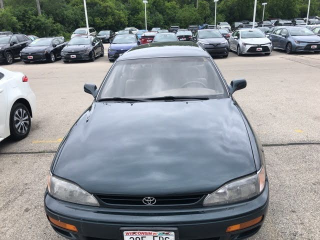The Good
The 1995 Toyota Camry's primary advantages are its unparalleled reliability and comfortable, quiet ride, making it a practical choice. Its efficient engines and low maintenance costs offer excellent long-term value. For emotional buyers, it provides peace of mind and the assurance of a vehicle that simply works, year after year, without fuss, embodying unwavering dependability.
The Bad
Known weaknesses for the 1995 Toyota Camry include potential rust, especially in colder climates. Age-related issues like power steering pump leaks, failing AC compressors, and worn suspension components are common. Its conservative design can also be perceived as bland, and performance, while adequate, isn't exciting. Watch for oil leaks from valve cover gaskets.
1995 Toyota Camry: Quick Overview
The 1995 Toyota Camry offered a practical range of specifications:
- Engine Options:
- 2.2-liter 5S-FE inline-four cylinder engine.
- 3.0-liter 1MZ-FE V6 engine.
- Horsepower:
- 4-cylinder: Approximately 125 horsepower at 5,400 rpm and 145 lb-ft of torque at 4,400 rpm.
- V6: Approximately 188 horsepower at 5,200 rpm and 203 lb-ft of torque at 4,400 rpm.
- Fuel Economy (EPA Estimates):
- 4-cylinder (manual/automatic): Around 23-24 MPG city / 29-30 MPG highway.
- V6 (automatic): Around 19-20 MPG city / 26-27 MPG highway.
- 0-60 MPH Times (Approximate):
- 4-cylinder: Roughly 9.5-10.5 seconds, depending on transmission.
- V6: Approximately 7.5-8.5 seconds.
- Towing Capacity:
- Generally limited. For the V6 models with proper equipment, it could be up to 2,000 pounds, but it's not a primary towing vehicle. The 4-cylinder is even less.
- Trim-Level Features:
- DX: The base model, typically featuring manual windows and locks, cloth upholstery, AM/FM stereo, and standard air conditioning. Power steering and dual airbags were standard.
- LE: The mid-range trim, adding popular features like power windows, power door locks, power mirrors, cruise control, a tilt steering wheel, and upgraded interior trim. A cassette player was common, and options like ABS were available.
- XLE: The top-tier luxury trim. Standard V6 engine (in some markets/years), alloy wheels, anti-lock brakes (ABS), power driver's seat, leather upholstery, a premium sound system with CD player option, and often a power moonroof. It offered a more refined experience with higher-end appointments.
Transmissions available included a 5-speed manual for the 4-cylinder engine and a 4-speed automatic for both engine options.
1995 Toyota Camry Specifications
Vehicle Information
| Year | 1995 |
| Make | Toyota |
| Model | Camry |
| Trim | - |
| Style | - |
| Type | Sedan |
| Category | Compact Car |
Manufacturing Details
| Made In | Japan |
| Manufacturing City | - |
Dimensions
| Doors | 4-Door |
| Curb Weight | - |
| Gross Vehicle Weight Rating | - |
| Overall Height | - |
| Overall Length | - |
| Overall Width | - |
| Wheelbase Length | - |
| Standard Seating | - |
Engine & Performance
| Engine | 5S |
| Engine Size | 2.2L |
| Engine Cylinders | 4 |
| Transmission | - |
| Transmission Type | - |
| Transmission Speeds | - |
| Drivetrain | Front-Wheel Drive |
Additional Features
| Anti-Brake System | - |
| Steering Type | - |
Pricing
| Manufacturer Suggested Retail Price (MSRP) | - |
| Invoice Price | - |
| Delivery Charges | - |
Vehicle History Report
Specifications
History
Events
History Check
Check
Check
Check
Check
Listings
Recalls
Check
Analysis
What Problems Does the 1995 Toyota Camry Have?
Oil leaks, particularly from the valve cover gaskets and occasionally the distributor O-ring (on the 4-cylinder engine), are very common. These are typically not catastrophic but can be messy and lead to oil consumption if neglected. Suspension components, such as struts, bushings, and tie rod ends, will wear out, affecting ride quality and handling. Minor electrical issues, like failing power window motors or door lock actuators, also crop up with age.
Regarding recalls, the 1995 Camry had a few, none of which were widely considered severe or indicative of major reliability issues. For instance, there were recalls related to certain steering column components, seat belt buckles, and, in some cases, fuel tank straps. These were generally addressed promptly and did not tarnish the Camry's strong reputation. There aren't typically year-specific widespread reliability concerns for the 1995 model that differ significantly from other XV10 Camrys; most problems are age-related across the generation. The engines and transmissions, particularly if regularly maintained with oil and fluid changes, are celebrated for their incredible longevity, often reaching 200,000, 300,000, or even 400,000 miles without major internal issues. Long-term concerns mainly focus on rust in body panels, subframes, and fuel lines in areas exposed to road salt, as well as the degradation of interior plastics and upholstery over time.
How long will the 1995 Toyota Camry last?
Its long-term durability is a major strength, primarily due to robust engine and transmission designs. However, over time, common weaknesses emerge: rust becomes a significant factor in colder climates, attacking wheel wells, rocker panels, and subframes. Rubber components like suspension bushings and engine mounts degrade, affecting ride and handling. Interior plastics can become brittle or faded, and upholstery shows wear. While the core mechanicals are incredibly tough, age-related peripheral component failures (e.g., AC, power steering, electrical accessories) are to be expected.
What Technology & Safety Features are Included?
Built-in Tech: The '95 Camry featured an analog gauge cluster with a speedometer, tachometer, fuel, and temperature gauges. Basic warning lights provided essential vehicle status. There was no integrated navigation, touchscreens, or complex digital displays; everything was straightforward and driver-focused.
Entertainment: Standard entertainment typically included an AM/FM radio with a cassette player. Higher trims (LE and XLE) could be optioned with a premium sound system, which often included a separate CD player or an in-dash CD changer, along with more speakers. Controls were physical buttons and knobs, simple and intuitive to operate.
Driver-Assistance Features: True driver-assistance technologies, as we know them today (e.g., adaptive cruise control, lane-keeping assist), were nonexistent. The closest it came was cruise control, which was standard on LE and XLE trims and optional on the DX.
Safety Features: The 1995 Camry made important strides in safety for its time. It came standard with dual front airbags for both the driver and front passenger across all trims, a significant offering for a mid-size sedan in the mid-90s. Anti-lock Braking System (ABS) was an optional feature on the LE trim and typically standard on the V6 XLE. Other standard safety features included three-point seatbelts for all outboard occupants, child safety locks on the rear doors, and reinforced side-impact door beams to enhance occupant protection in side collisions.
Crash-Test Ratings: According to the National Highway Traffic Safety Administration (NHTSA) tests from that period, the 1995 Toyota Camry generally performed well for its class. It received a 4-star rating for both driver and passenger frontal impact protection. Side-impact testing was not as prevalent or refined as today, but its robust construction contributed to a perception of solid crashworthiness for its time. It's crucial to note that these ratings are based on 1995 standards and are not comparable to modern crash-test ratings, which are significantly more stringent.
What Colors Options are Available?
1995 Toyota Camry Prices and Market Value
Today, the 1995 Camry has completed its depreciation cycle. Current used market prices are extremely low, ranging from a few hundred dollars for a running but rough example to $3,000-$5,000 for exceptionally well-maintained, low-mileage vehicles. Factors affecting this minimal resale value include overall condition, mileage, rust presence, functionality of all features (especially AC), and maintenance history. While its initial depreciation was standard for a mass-market sedan, its legendary reliability meant it held value better than many domestic rivals through its first decade. Now, its "value" is primarily its utility as incredibly affordable, dependable transportation rather than its market price.
1995 Toyota Camry Cost of Ownership
1995 Toyota Camry Fuel Efficiency
1995 Toyota Camry Safety Rating
NHTSA
1995 Toyota Camry Insurance
reasonable repair costs.
How Does the 1995 Toyota Camry Compare to Other Sedan?
Performance: The Camry's 4-cylinder engine provided adequate, smooth performance, similar to the Accord's. The optional V6, however, offered a significant power advantage over many competitors' four-cylinders and was competitive with other V6 offerings, such as the Taurus's. It was never a "driver's car" like the sportier Nissan Altima or Mazda 626, prioritizing comfort and refinement over agile handling.
Features: Feature-wise, the Camry was competitive with the Accord, offering similar trim levels (DX, LE, XLE) with comparable amenities like power accessories, cruise control, and optional ABS. It generally offered a higher perception of quality and durability in its interior fit and finish compared to its domestic rivals, the Ford Taurus and Chevy Lumina, which often suffered from cheaper plastics and more frequent build quality issues.
Reliability: This is where the Camry truly shined, arguably setting the benchmark in its class alongside the Honda Accord. Its powertrain (both 4-cylinder and V6) and automatic transmission were exceptionally robust, leading to legendary longevity. It consistently outranked the Altima, Taurus, and Lumina in long-term reliability surveys, which often plagued owners with more frequent and expensive repairs, especially as they aged. The Camry's reputation for simply "not breaking" was a key differentiator.
Price: New, the Camry was competitively priced with the Accord and often a bit more expensive than the domestic offerings. However, its superior long-term reliability and build quality meant it typically held its resale value better through the initial depreciation curve. In the current used market, its price is incredibly low due to age, but its inherent reliability still makes it a fantastic value proposition compared to other aging sedans that might require more costly upkeep.
Alternatives:
- Honda Accord (1994-1997 generation): A very similar alternative in terms of reliability, efficiency, and comfort. Often a slightly sportier driving feel.
- Mazda 626 (1993-1997 generation): For those seeking a more engaging driving experience, the 626 offered better handling, though typically not the same bulletproof reliability as the Camry or Accord.
- Nissan Altima (1993-1997 generation): A sportier, more aggressive-looking option, but generally considered less robust in the long run than the Toyota or Honda.
Final Verdict: Is the 1995 Toyota Camry a Good Sedan?
Conditions for purchase are crucial: look for examples with minimal rust, a well-documented maintenance history, and all major systems (engine, transmission, AC) functioning correctly. A pre-purchase inspection by a trusted mechanic is non-negotiable due to its age. Trims like the LE offer the best balance of features and value, while the XLE provides more comfort. The 4-cylinder is sufficient and more economical; the V6 offers stronger acceleration. Avoid neglected examples, as repairs can quickly exceed its low purchase price. When well-maintained, the 1995 Camry remains an outstanding value for basic, no-fuss motoring.


